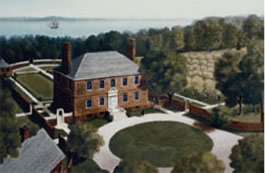|
|
 |
The Eighteenth Century
The Eighteenth Century:
Fairfax County's "Golden Age"
In about 1750, if you had journeyed to Northern Virginia from England or from other colonies on the Atlantic seaboard, chances are that you would have arrived by ship. Navigable rivers like the Potomac were the main commercial arteries of the Virginia colony. These eighteenth century highways carried the commodities that established and maintained the great colonial fortunes: tobacco, grain, and slaves. They also wove together the social and political fabric of the colony, for those who lived along and traveled the rivers generally held positions of power. From each plantation’s river landing, the sons of Virginia’s planters embarked to be schooled in England. One after another, poised upon the bluffs above the river, stood the imposing residences of Virginia’s colonial elite—the tangible and visible symbols of each planter’s wealth and power.
As your ship sailed slowly north of the Occoquan River, with its small settlement at the town of Colchester, four such manors would slowly have come into view: George Mason’s Gunston Hall, Col. Dennis McCarty’s Cedar Grove and Mount Air; William Fairfax’s Belvoir, and Lawrence Washington’s Mount Vernon. Two of these homes—Cedar Grove and Belvoir—lay within the present boundaries of Fort Belvoir. Gunston Hall and Mount Vernon survive, but Belvoir and Cedar Grove remain only as archeological sites.
William Fairfax, builder of Belvoir, arrived in the Virginia colony in the 1730s from Massachusetts, where he had served as Collector of Customs for the Crown. From 1734 to 1741, Fairfax and his wife Deborah lived along the lower Potomac, where William again assumed the position of Collector of Customs and acted as land agent for his cousin, Thomas, Sixth Lord Fairfax, proprietor of the massive Northern Neckland grant.
In ca. 1932, Colonel Edward Schulz uncovered the massive foundations of the Belvoir Manor Houseand
its dependencies.
|
|
During this time, he also assembled the property and constructed the dwelling complex at Belvoir Manor. Fairfax’s elegant new home was completed in 1741. Historic documents and archeological remains found at Belvoir Manor both attest to the elegant lifestyle enjoyed by the Fairfax family. William Fairfax called his manor Belvoir, a French word meaning “beautiful to see.” The mansion itself, described in a 1774 rental notice, was spacious and well-appointed. Its furnishings consisted of “tables, chairs, and every other necessary article...very elegant.” Ceramics imported from Europe and the Orient graced its tables. Prominent citizens of the colony, including GeorgeWashington, a neighbor and a close friend, visited frequently, and Thomas Sixth Lord Fairfax, the only member of the British nobility ever to reside in the colonies, lived at Belvoir before he moved to the Shenandoah Valley.

Belvoir’s slaves either made or used coarse unglazed earthenware pots such as this one. |
Despite the grandeur of their surroundings and the refinement of their furnishings, planters like the Masons, McCartys, Washingtons, and Fairfaxes did not lead indolent lives. Conscious of their civic duty, they were the political, social, economic, and religious leaders of their immediate neighborhood and of the colony at large.
William Fairfax was a case in point. As President of the Governor’s Council in Williamsburg, he held a position equivalent to today’s Lieutenant Governor; in this position, he represented the colony at an important conference with the Iroquois Indians in 1753. It was he who introduced the bill that created Fairfax County as a separate political jurisdiction in 1742, and he subsequently served as presiding Justice of the County Court, and as County Lieutenant, the county’s chief law-enforcement officer. At the same time, he managed his own large properties throughout Fairfax County and served as the land agent for his cousin, Lord Fairfax. George William Fairfax, William’s son and heir and a close personal friend of George Washington, continued his father’s tradition of public service.
While the contributions of these eighteenth century leaders certainly were substantial, their lives must also be viewed in a broader perspective.
 An artist’s rendering of the Belvoir Manor.
An artist’s rendering of the Belvoir Manor.
|
Planters like William Fairfax comprised a very small portion of Fairfax County’s population: most of their neighbors were smaller farmers who sometimes barely managed to make a living. Moreover, the affluence of these planters was based not only on land and imposing buildings, but on the number of slaves they held. Slaves too are in the records—as chattel passed from one generation to another, and as the probable users of the plain unglazed ceramics found in the outbuildings of Belvoir Manor.
[ Belvoir in the Seventeenth Century
| Belvoir in the Antebellum Period ]
|

|


